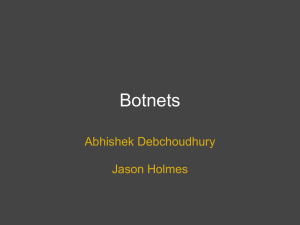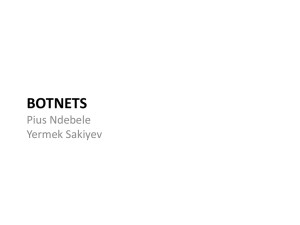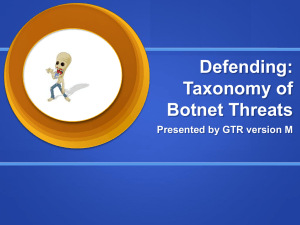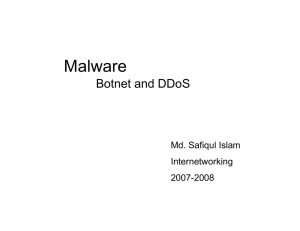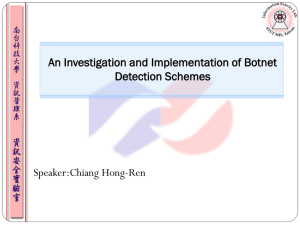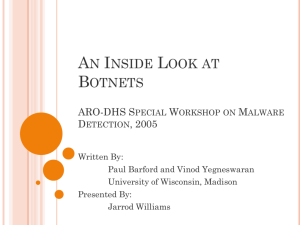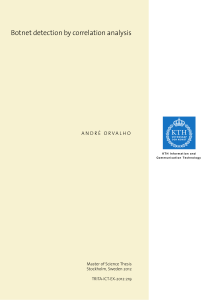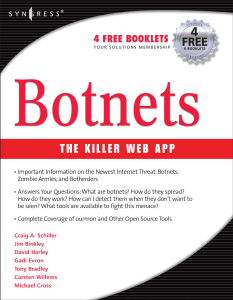CAP6135: Malware and Software Vulnerability Analysis Botnets Cliff Zou
advertisement
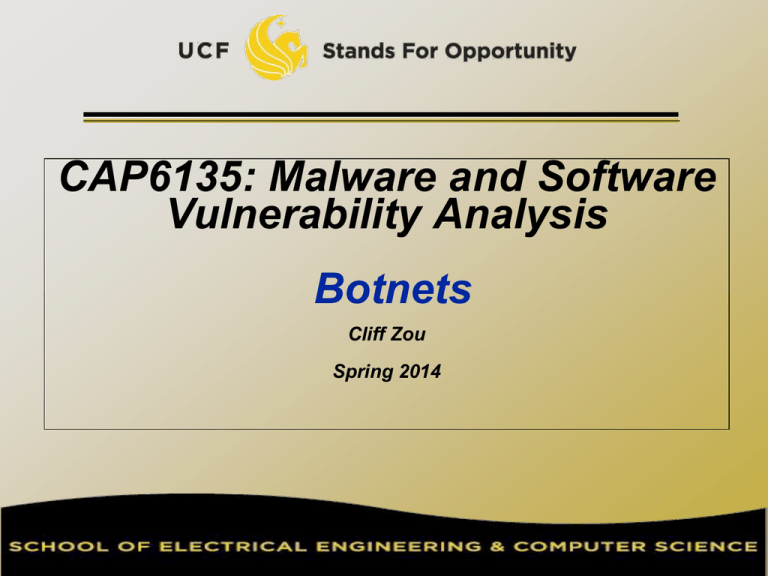
CAP6135: Malware and Software Vulnerability Analysis Botnets Cliff Zou Spring 2014 Acknowledgement This lecture uses some contents from the lecture notes from: Dr. Dawn Song: CS161: computer security Richard Wang – SophosLabs: The Development of Botnets Randy Marchany - VA Tech IT Security Lab: Botnets 2 Botnets Collection of compromised hosts Spread like worms and viruses Once installed, respond to remote commands A network of ‘bots’ robot : an automatic machine that can be programmed to perform specific tasks. Also known as ‘zombies’ 3 Platform for many attacks Spam forwarding (70% of all spam?) Click fraud Keystroke logging Distributed denial of service attacks Serious problem Top concern of banks, online merchants Vint Cerf: ¼ of hosts connected to Internet 4 What are botnets used for? 5 IRC (Internet Relay Chat) based Control 6 IRC (Internet Relay Chat) based Control 7 Why IRC? IRC servers are: freely available easy to manage easy to subvert Attackers have experience with IRC IRC bots usually have a way to remotely upgrade victims with new payloads to stay ahead of security efforts 8 How bad is the problem? Symantec identified a 400K node botnet Netadmin in the Netherlands discovered 1-2M unique IPs associated with Phatbot infections. Phatbot harvests MyDoom and Bagel infected machines. Researchers in Gtech monitored thousands of botnets 9 Spreading Problem Spreading mechanism is a leading cause of background noise Port 445, 135, 139, 137 accounted for 80% of traffic captured by German Honeynet Project Other ports 2745 3127 3410 5000 – – – – bagle backdoor MyDoom backdoor Optix trojan backdoor upnp vulnerability 10 Most commonly used Bot families Agobot SDBot SpyBot GT Bot Agobot Most sophisticated 20,000 lines C/C++ code IRC based command/control Large collection of target exploits Capable of many DoS attack types Shell encoding/polymorphic obfuscation Traffic sniffers/key logging Defend/fortify compromised system Ability to frustrate dissassembly SDBot Simpler than Agobot, 2,000 lines C code Non-malicious at base Utilize IRC-based command/control Easily extended for malicious purposes Scanning DoS Attacks Sniffers Information harvesting Encryption SpyBot <3,000 lines C code Possibly evolved from SDBot Similar command/control engine No attempts to hide malicious purposes GT Bot Functions based on mIRC scripting capabilities HideWindow program hides bot on local system Basic rootkit function Port scanning, DoS attacks, exploits for RPC and NetBIOS Variance in codebase size, structure, complexity, implementation Convergence in set of functions Possibility for defense systems effective across bot families Bot families extensible Agobot likely to become dominant Control All of the above use IRC for command/control Disrupt IRC, disable bots Sniff IRC traffic for commands Shutdown channels used for Botnets But a botnet could use its own IRC server IRC operators play central role in stopping botnet traffic Automated traffic identification required Future botnets may move away from IRC Move to P2P communication Traffic fingerprinting still useful for identification Host control Fortify system against other malicious attacks Disable anti-virus software Harvest sensitive information PayPal, software keys, etc. Economic incentives for botnets Stresses need to patch/protect systems prior to attack Stronger protection boundaries required across applications in OSes Example Botnet Commands Connection Pass hierarchy info CLIENT: PASS <password> HOST : (if error, disconnect) CLIENT: NICK <nick> HOST : NICKERROR | CONNECTED BOTINFO <nick> <connected_to> <priority> BOTQUIT <nick> 19 Example Botnet Commands IRC Commands CHANJOIN <tag> <channel> CHANPART <tag> <channel> CHANOP <tag> <channel> CHANKICK <tag> <channel> CHANBANNED <tag> <channel> CHANPRIORITY <ircnet> <channel> <LOW/NORMAL/HIGH> 20 Example Botnet Commands pstore bot.execute Run executable on remote system bot.open Display all usernames/passwords stored in browsers of infected systems Reads file on remote computer bot.command Runs command with system() 21 Example Botnet Commands http.execute Download and execute file through http ftp.execute ddos.udpflood ddos.synflod ddos.phaticmp redirect.http redirect.socks 22 Current Botnet Control Architecture botmaster C&C C&C bot bot bot •More than one C&C server •Spread all around the world 23 Botnet Monitor: Gatech KarstNet A lot bots use DynDNS name to find C&C C&C C&C cc1.com KarstNet informs DNS provider of cc1.com attacker Detect cc1.com by its abnormal DNS queries bot DNS provider maps cc1.com to Gatech sinkhole (DNS hijack) bot bot KarstNet sinkhole All/most bots attempt to connect the sinkhole 24 Botnet Monitor: Honeypot Spy Security researchers set up honeypots Honeypots: deliberately set up vulnerable machines When compromised, put close monitoring of malware’s behaviors Tutorial: http://en.wikipedia.org/wiki/Honeypot_%28computing%29 When compromised honeypot joins a botnet Passive monitoring: log all network traffic Active monitoring: actively contact other bots to obtain more information (neighborhood list, additional c&c, etc.) Representative research paper: A multifaceted approach to understanding the botnet phenomenon, Abu Rajab, Moheeb and Zarfoss, Jay and Monrose, Fabian and Terzis, Andreas, 6th ACM SIGCOMM conference on Internet measurement (IMC), 2006. 25 The Future Generation of Botnets Peer-to-Peer C&C Polymorphism Anti-honeypot Rootkit techniques 26

